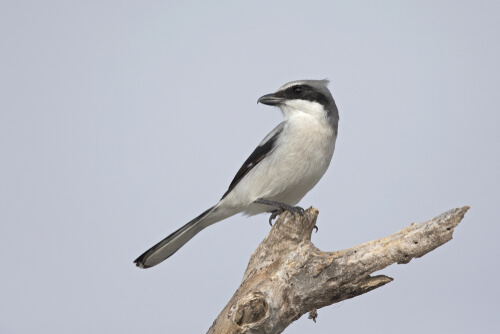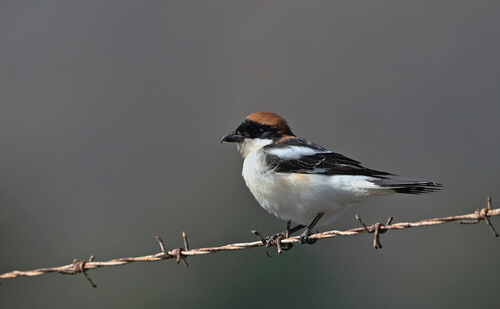
| Kingdom | Animalia |
| Phylum | Chordata |
| Class | Aves |
| Order | Passeriformes |
| Family | Laniidae |
| Genera | Lanius, Eurocephalus, Corvinella, Urolestes |
| Niche | Predatory songbird |
| Length | 6-9 in (16-25 cm) |
| Weight | 0.75-2.25 oz (21-64 g) |
| Lifespan | 7 years |
| Social Structure | Monogamous, territorial |
| Conservation Status | Least concern |
| Preferred Habitat | Savannah, grasslands |
| Average Clutch Size | 5-6 eggs |
| Main Food Items and Prey | Rodents, snakes, lizards, insects |
| Predators | Magpies, crows, weasels |
The Basics
Shrike is a family of medium-sized birds comprised of four genera and several species. Most range in Eurasia and Africa, while two species breed in North America. Their family name, Laniidae, is derived from the Latin word ‘butcher’ which describes shrike feeding habits. Their common name ‘shrike’ is derived from an Old English word similar to modern-day ‘shriek’, alluding to their harsh call. Some shrikes are migratory, moving north in the summer to breed and closer to the equator during the winter months.
Most shrike species have a combination of black, brown, white, and blue feathers and weigh about 1-2.5 oz (21-64 g). They have long tail feathers and grow to about 6-9 in (16-25 cm). Like eagles and other birds of prey, they have hooked beaks. On either side of their upper bill, there is a toothlike spike with corresponding notches on the lower mandible. These fit together, allowing them to quickly kill their prey.
With distributions in Africa and Eurasia, most shrike species inhabit grasslands and savannah. However, some species will inhabit forests and woodlands instead. Two species – the loggerhead and northern shrikes – live in North America and one species reaches as far as New Guinea.

Predator and Prey
Shrikes are predators and will eat various animals. They make use of perches, standing tall and upright to spot their prey and to advertise themselves to other males. They hunt small insects and lizards, often impaling them on thorns. Shrike will even show up at domestic bird feeders to hunt the smaller birds that visit them. Also, shrike will hunt small rodents and snakes, grabbing them with their pointed beaks by the neck and aggressively shaking them to kill them.
Shrikes are vulnerable to prey by various larger birds such as magpies and crows. Snakes will also attack them and will eat their eggs if the opportunity presents itself. Also, domestic cats kill billions of songbirds every year, including shrike. Despite this, shrikes are still common in most of their ranges and are listed as “Least Concern” on the IUCN red list.
Nesting and Reproduction
Shrikes are territorial. They generally form monogamous pairs between males and females and aggressively defend their territories together. For species that migrate, they typically defend territories in both their summer breeding grounds and their winter feeding grounds.
During courtship, males will perform elaborate displays, sometimes mimicking hunting and cache-building behaviors while she watches. He will also feed the female to convince her to mate. Shrikes build cup-shaped nests out of branches and grasses in trees and bushes. Hidden inside this nest, females typically lay 5-6 eggs. After about 15 days of incubation, the chicks will emerge from their shells. Both parents, as well as the previous brood’s young in some species, will help rear the young.

Fun Facts about Shrike!
It is rare for songbirds to be predatory. But shrikes are fascinating birds and demonstrate various types of unique behaviors, some of which have inspired various fictional novels and stories invoking the bird’s compelling behaviors.
Nature’s Serial Killer
Shrikes are known to catch their prey and impale them on sharp objects such as thorns. Loggerhead shrike has been known to impale their prey on barbed wire fences, creating apparent displays of their victims. This allows them to break their prey into smaller pieces for consumption and also allows them a spot to keep their food for another time. This cache, which sometimes includes decorative and non-edible items, may also work as an advertisement by males to attract females.
Sun-Dried Hoppers
This impaling and caching behavior may even help them eat prey that they may not otherwise be able too. For example, a toxic grasshopper occurs within the range of some shrike known as the lubber grasshopper (Romalea microptera). The birds will catch it, but instead of consuming too early and becoming ill, they will allow it to remain impaled for at least two days. At this point, the toxins in its body are broken down and it is no longer dangerous for the shrike to consume it.

Cooperative Kids
Despite their reputation as ruthless hunters, shrikes are helpful when it comes to helping their own families. Several species of shrike, including all of the genera Eurocephalus and Corvinella and one species of Lanius display cooperative breeding behavior. This is characterized by young birds – usually those of the year before – helping to raise the next generation of young from the current year.
